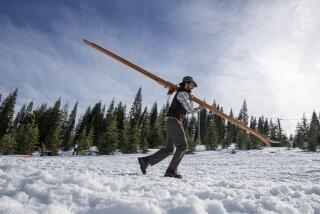Catching mono
- Share via
A budding alpine skier in Chicago learns to develop a good imagination. The ski club I joined at age 12 bused me every Saturday morning to the lofty realm of Wilmot Mountain, Wis. After years of skiing on 300 vertical feet, I was utterly bored (though an expert skier by Midwest standards).
So for a challenge, I started dropping one ski off the chairlift. I made sure not to drop it on anyone’s head. Then I skied down the hill on one ski. (I found out this is how the U.S. ski team practiced.) Soon after, I tried shorter skis to do some trick skiing. Though I did learn some moves, I was still looking for my niche. That’s when I rented a Warren Miller ski video that had a scene of a man skiing on one, wide ski. His feet were side-by-side, facing forward. Miller said it was a monoski, noting in his deadpan style that it was a great way to not only break one leg but both at the same time. My search was over. Sort of. After numerous calls, I found a ski shop two hours away that sold monoskis and bought the larger of the two models available.
I immediately took my monoski to Wilmot to test it out. As expected, I fell quite a bit. I also learned that I only had one edge to carve with -- similar to a snowboard. I figured out turns were controlled by rolling my knees from side to side. The only way to stop or slow down was to do a “hockey stop.” But I didn’t have to worry about crossing my tips.
After two years I was an expert Midwest monoskier. And I was on my own. Ski schools barely knew what a monoski was, let alone how to hone my abilities. I was a curiosity wherever I went. One lift operator forced me to take a boot out of the binding. He thought it was a snowboard.
I got weird looks and unending questions. People in line behind me whispered, “Look at that! It’s a really long snowboard, but his feet are together. Wait! He has poles, bindings and boots.” I got static from the old guard, with lines such as “Why don’t you just ski on two skis like everybody else?”
I began to realize how unique this sport is, not to mention how many misconceptions there are about it. But I remained committed to the monoski experience.
The independence can’t be matched. When you’re on a monoski, you make easy work of moguls, since there’s no worry about two planks separating. Then there are the powder days. On one deep run I noticed snowboarders passing the skiers. And then I started passing the snowboarders. The monoski was literally floating on top of the powder.
Secretly, I relished my newfound attention(especially when people are cheering me on because they’ve never seen a monoski before). Although I saw a few other monoskiers over the years, I was never close enough to talk to one.
Then recently I went to Lake Tahoe. As I got off the chairlift one day, there was a welcome surprise -- a demo tent set up by a monoski manufacturer. I tried one of the company’s products later and was quite pleased. The only monoski I had used was the ski I had bought 12 years earlier. The new equipment felt lighter and was much more forgiving.
It was a sign of the new dawn for my obscure passion. John Carpenter, president of Snowshark Monoskis, which sells to the U.S. and European markets, said his business was up more than 100% the last three years, with an increase in sales of 340% last year. “Monoskiing is a lot easier to learn than skiing or snowboarding,” Carpenter said. “It’s the best powder ride.”
He estimated there are 1,000 to 1,500 monoskiers in the U.S. and 6,000 to 7,000 in Europe.
While at Tahoe, I ran into monoskiers who were there for the demo event. They immediately said hello and asked how my day was. I could see my friends on skis and snowboards were jealous, because when you monoski, it’s like being in an elite club. But the club is open to anyone brave enough to try it.
All you need is a 300-foot hill.
For more information, try the U.S. Monoski Assn. at www.usmonoski.org.
More to Read
Sign up for The Wild
We’ll help you find the best places to hike, bike and run, as well as the perfect silent spots for meditation and yoga.
You may occasionally receive promotional content from the Los Angeles Times.






